Abstract
The deoxyribonucleic acid base composition of 15 species of yeasts was determined to obtain further clues to or supporting evidence for their taxonomic position. Species examined belonged to the genera Saccharomyces, Debaryomyces, Lodderomyces, Metschnikowia, and Candida. The range of moles per cent guanine plus cytosine (GC content) for all yeasts examined extended from 34.9 to 48.3%. The sporogenous species and the asporogenous yeasts spanned the range with 36.6 to 48.3% GC and 34.9 to 48% GC, respectively. Three Saccharomyces species (S. rosei and related species) exhibited significantly higher GC contents than S. cerevisiae, whereas the fermentative species D. globosus revealed a%GC more aligned to the S. rosei group than to the nonfermentative D. hansenii. Similar GC contents were demonstrated by L. elongasporus and its proposed imperfect form C. parapsilosis. The range of GC contents of various strains of three Metschnikowia species studied was 6.1%, with the type strain of M. pulcherrima having the highest GC content (48.3%) of all of the yeasts examined.
Full text
PDF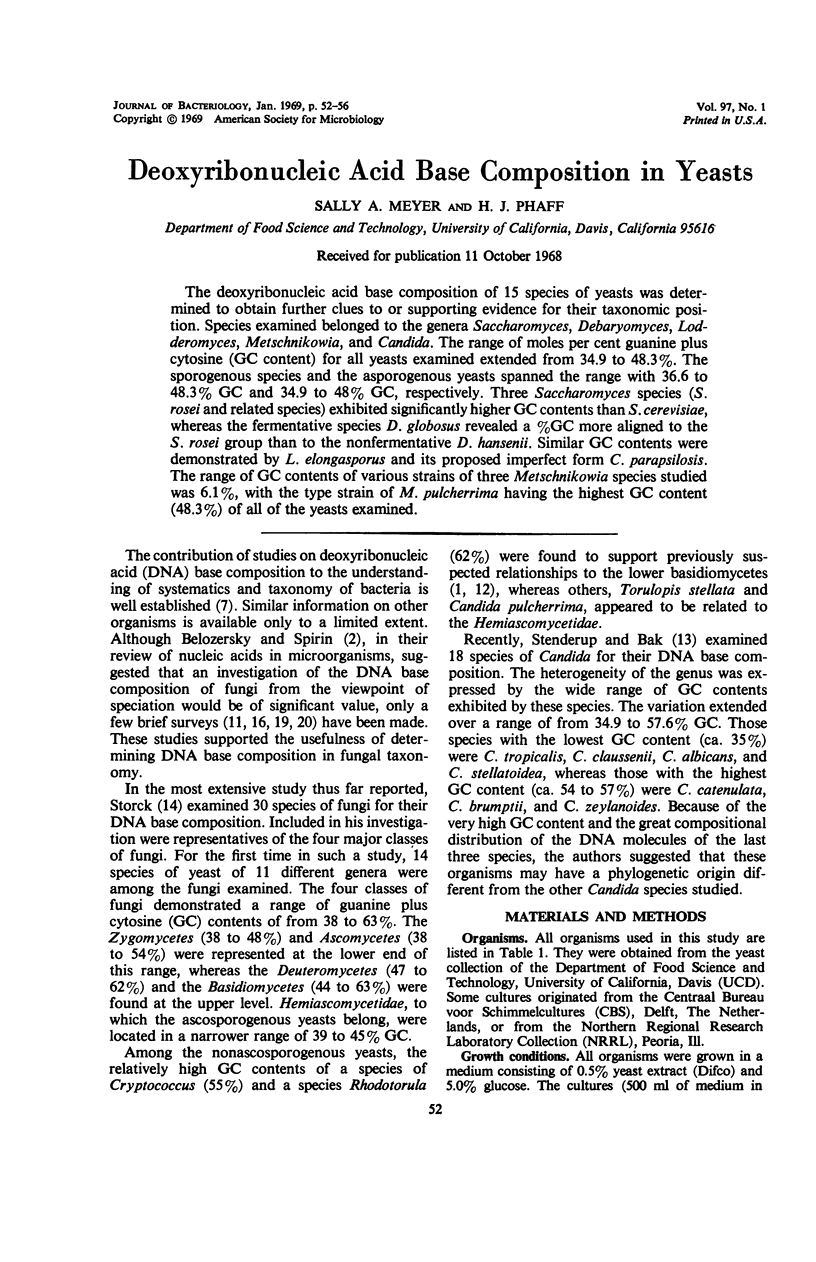
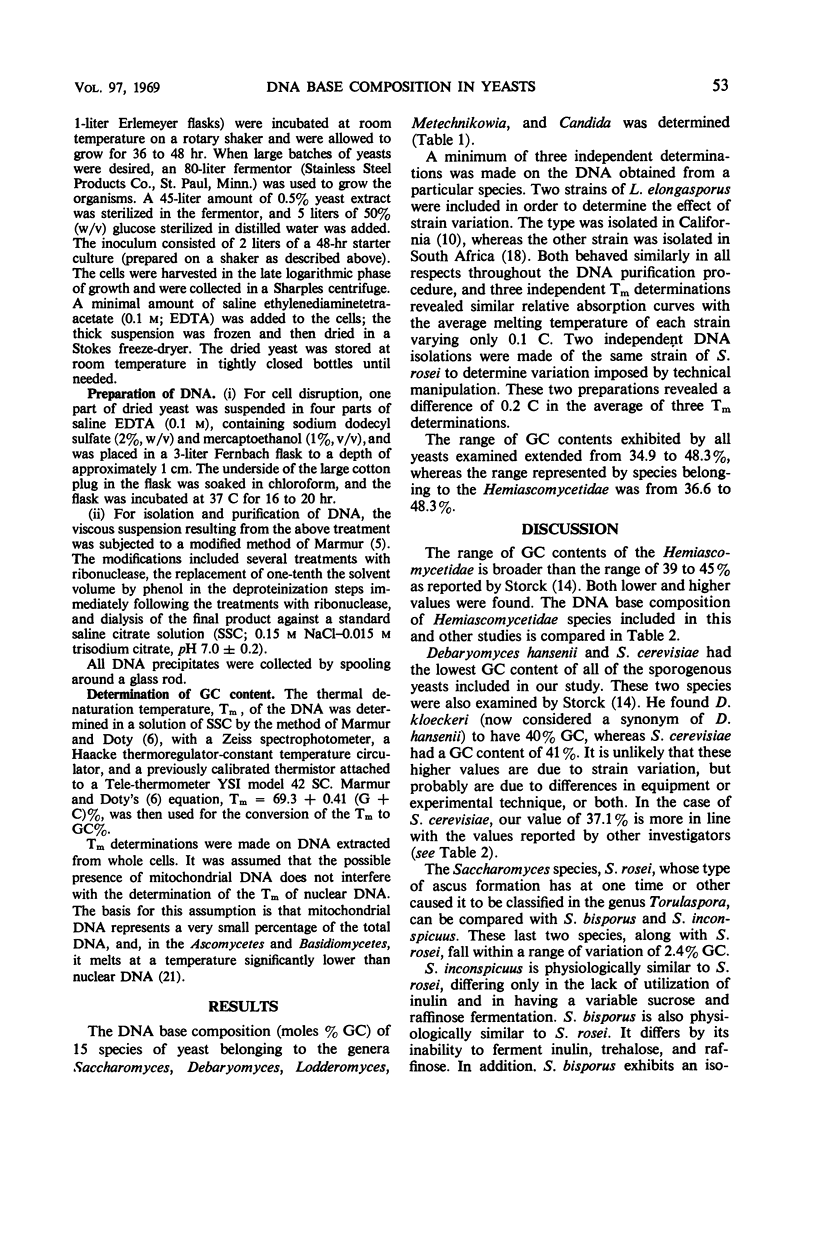
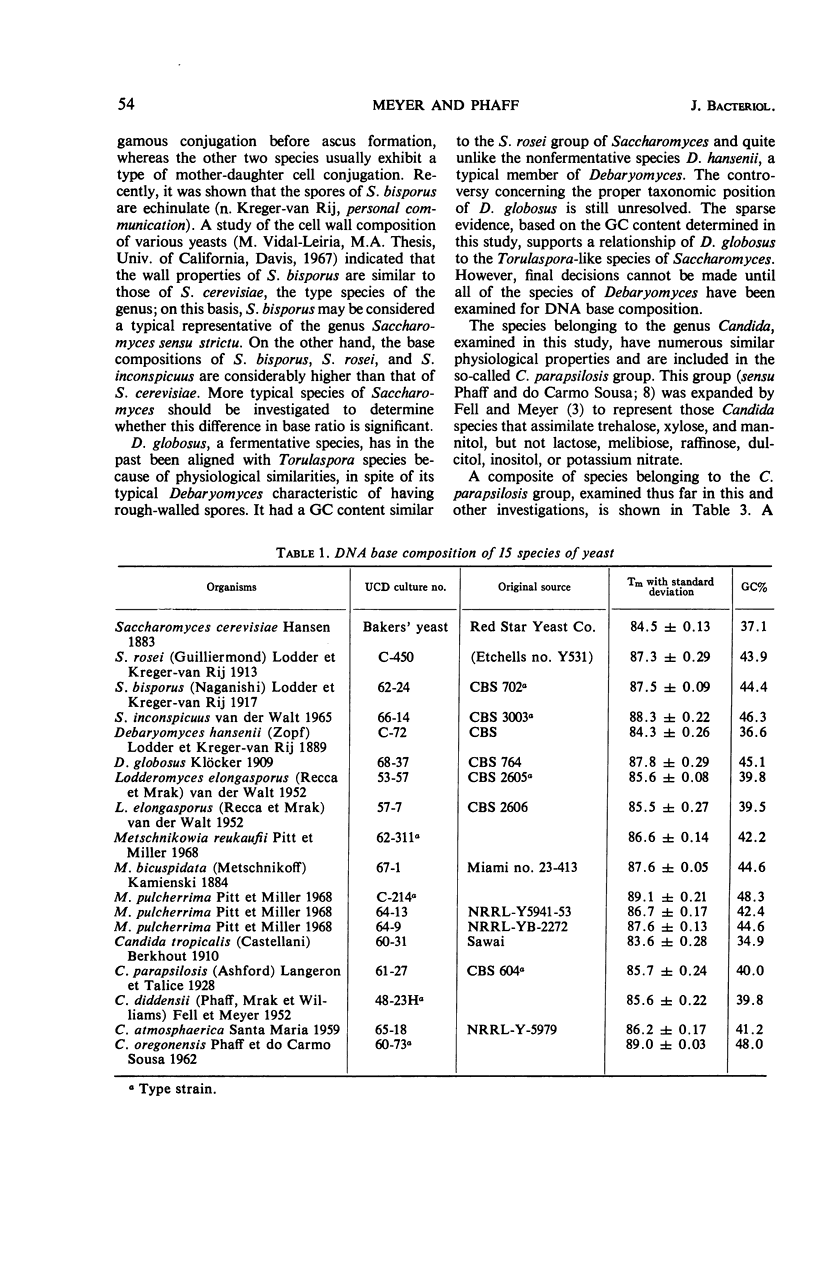
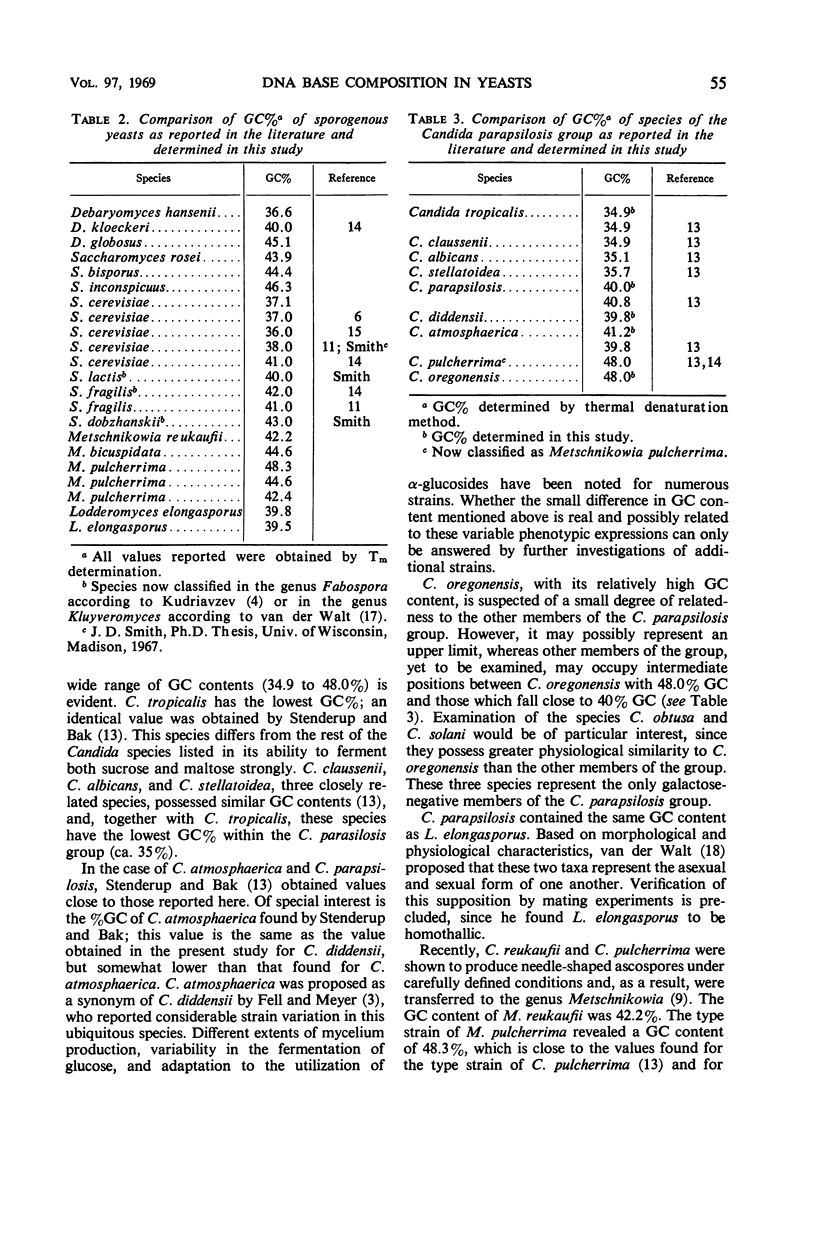
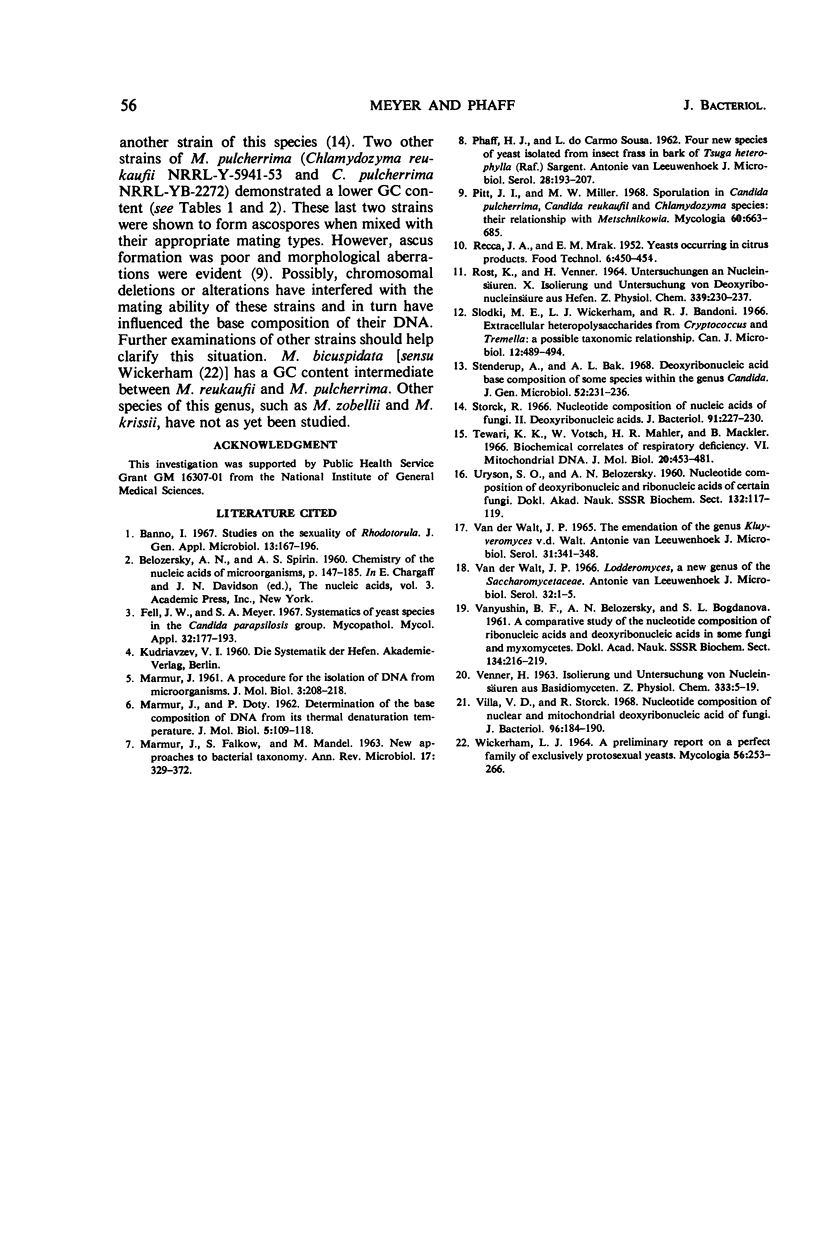
Selected References
These references are in PubMed. This may not be the complete list of references from this article.
- Fell J. W., Meyer S. A. Systematics of yeast species in the Candida parapsilosis group. Mycopathol Mycol Appl. 1967 Aug 14;32(3):177–193. doi: 10.1007/BF02049795. [DOI] [PubMed] [Google Scholar]
- MARMUR J., DOTY P. Determination of the base composition of deoxyribonucleic acid from its thermal denaturation temperature. J Mol Biol. 1962 Jul;5:109–118. doi: 10.1016/s0022-2836(62)80066-7. [DOI] [PubMed] [Google Scholar]
- MARMUR J., FALKOW S., MANDEL M. NEW APPROACHES TO BACTERIAL TAXONOMY. Annu Rev Microbiol. 1963;17:329–372. doi: 10.1146/annurev.mi.17.100163.001553. [DOI] [PubMed] [Google Scholar]
- PHAFF H. J., do CARMO-SOUSA Four new species of yeast isolated from insect frass in bark of Tsuga heterophylla (Raf.) Sargent. Antonie Van Leeuwenhoek. 1962;28:193–207. doi: 10.1007/BF02538734. [DOI] [PubMed] [Google Scholar]
- Rost K., Venner H. Untersuchungen an Nucleinsäuren. X. Isolierung und Untersuchung von Desoxyribonucleinsäure aus Hefen. Hoppe Seylers Z Physiol Chem. 1964;339(1):230–237. [PubMed] [Google Scholar]
- Slodki M. E., Wickerham L. J., Bandoni R. J. Extracellular heteropolysaccharides from Cryptococcus and Tremella. A possible taxonomic relationship. Can J Microbiol. 1966 Jun;12(3):489–494. doi: 10.1139/m66-071. [DOI] [PubMed] [Google Scholar]
- Storck R. Nucleotide composition of nucleic acids of fungi. II. Deoxyribonucleic acids. J Bacteriol. 1966 Jan;91(1):227–230. doi: 10.1128/jb.91.1.227-230.1966. [DOI] [PMC free article] [PubMed] [Google Scholar]
- Tewari K. K., Vötsch W., Mahler H. R., Mackler B. Biochemical correlates of respiratory deficiency. VI. Mitochondrial DNA. J Mol Biol. 1966 Oct;20(3):453–481. doi: 10.1016/0022-2836(66)90003-9. [DOI] [PubMed] [Google Scholar]
- VENNER H. UNTERSUCHUNGEN AN NUCLEINSAEUREN. II. ISOLIERUNG UND UNTERSUCHUNG VON NUCLEINSAEUREN AUS BASIDIOMYCETEN. Hoppe Seylers Z Physiol Chem. 1963;333:5–19. doi: 10.1515/bchm2.1963.333.1.5. [DOI] [PubMed] [Google Scholar]
- Villa V. D., Storck R. Nucleotide composition of nuclear and mitochondrial deoxyribonucleic acid of fungi. J Bacteriol. 1968 Jul;96(1):184–190. doi: 10.1128/jb.96.1.184-190.1968. [DOI] [PMC free article] [PubMed] [Google Scholar]
- van der Walt J. P. Lodderomyces, a new genus of the Saccharomycetaceae. Antonie Van Leeuwenhoek. 1966;32(1):1–5. doi: 10.1007/BF02097439. [DOI] [PubMed] [Google Scholar]
- van der Walt J. P. The emendation of the genus Kluyveromyces v. d. Walt. Antonie Van Leeuwenhoek. 1965;31(4):341–348. doi: 10.1007/BF02045913. [DOI] [PubMed] [Google Scholar]


